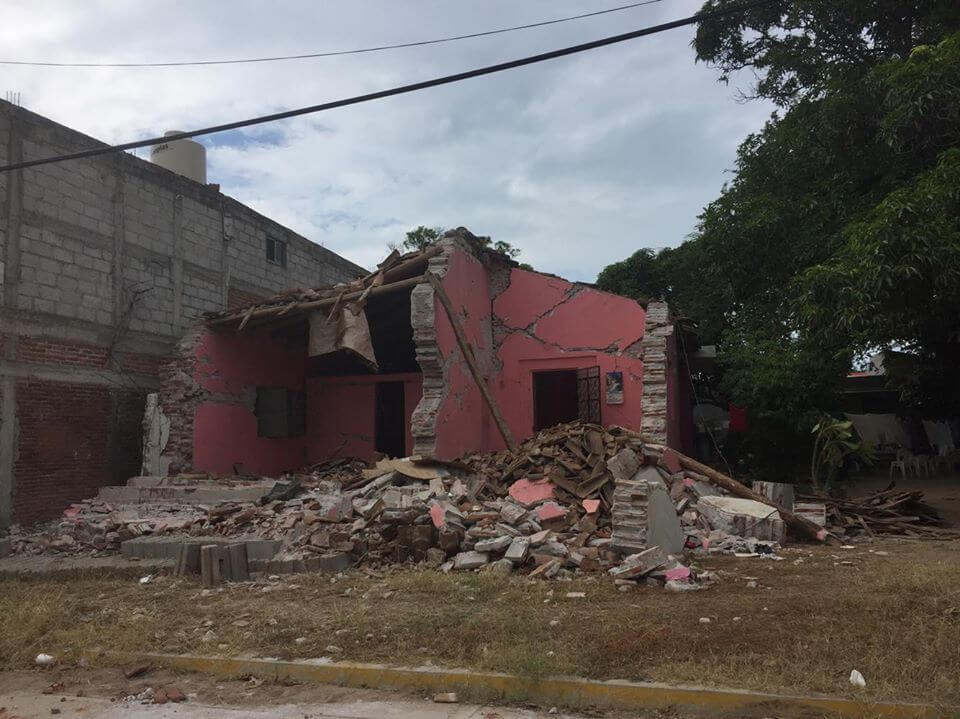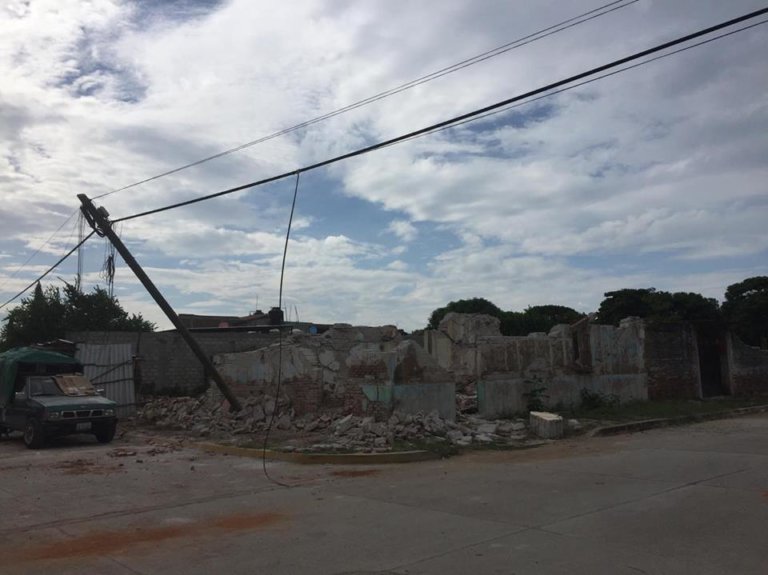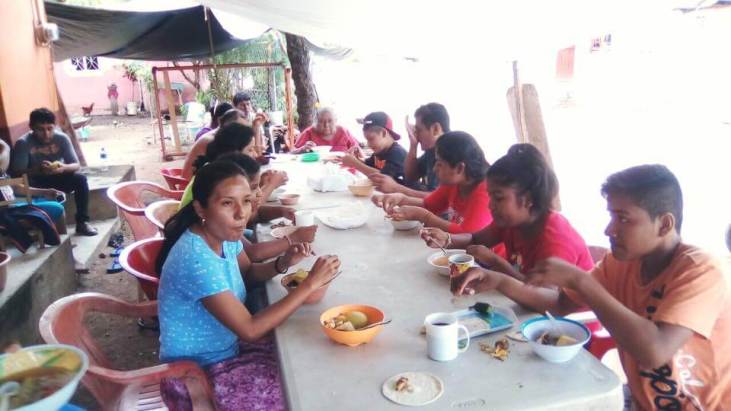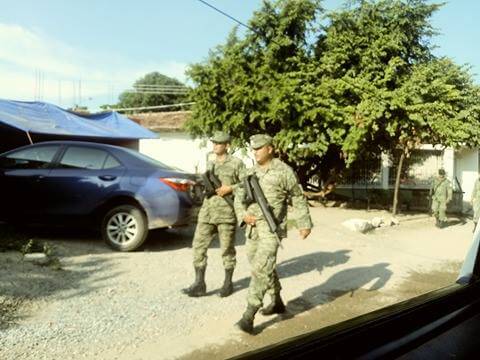Filed under: Action, Disaster, Mexico, Southern Mexico

Two strong earthquakes battered Mexico this September. The first, with a magnitude of 8.1 degrees, hit the states of Chiapas and Oaxaca on September 7th; the second arrived on September 19th with a magnitude of 7.1 degrees, affecting areas in Puebla, Morelos, Mexico City, and Mexico State. In Oaxaca in the South of Mexico, two of the most devastated zones were the Isthmus of Tehuantepec and the neighboring Sierra.
With around 100 deaths and even more injuries, the population of this area is in great pain. In various municipalities 80% of homes were destroyed, and hospitals, public buildings, and roads were reduced to rubble. Most of the region’s electric system, in addition to the wells which were the main source of drinking water for residents, were also ravaged. Tens of thousands of people have lost everything and are now living on the streets in the middle of the rainy season. To date, the earth has not stopped shaking—not as strong as before but enough to perpetuate a climate of fear amongst inhabitants, and enough to cause houses and bridges to continue to collapse. On September 23, a strong aftershock killed and injured several more people.
The magnitude of this disaster was never really reported in the media, and in many cities and villages people are still waiting for official help to arrive. When it finally does come, it is under the control of the army or corrupt political parties, who exchange their “donations” for votes or promises to support the capitalist projects that destroy communities. This is the result of a racist handling of the catastrophe—one that renders invisible and attacks Indigenous peoples who have already been impoverished and marginalized by a political system inherited directly from colonialism. In Oaxaca, the communities most affected by the quake are predominantly native peoples, specifically Ikoots, Zapoteco and Ayuuk (Mixe).
This is what Autonomous Solidarity Looks Like
Faced with disaster, the only viable option has been solidarity: dozens of autonomous collection centers have been established in various cities, with the aim of gathering food, drinking water, personal hygiene products, tools, tarps, camping tents, medications, and more. Then volunteers organize support brigades to deliver the donations to affected neighborhoods and communities, which in turn organize the distribution of provisions in addition to managing shelters and community kitchens.
In the barrios and indigenous communities of Oaxaca, solidarity and communal organization are not only a necessity, they are also an ancestral collective practice and a political force marked by five centuries of resistance to (neo-)colonialism. It is in solidarity with these autonomous efforts that we are organizing this fundraiser, which will support the cities and peoples who are fighting to rise up with dignity despite this disaster.
All funds collected will be delivered equally to two different autonomous brigades. One of the brigades is comprised of collectives and organizations that work directly with affected communities, taking aid and supporting the community in alternative healing practices. The other brigade is composed of 2 doctors and other volunteers taking aid and engaging in medical assistance and now setting up two community kitchens feeding approximately 13 – 15 families.
As a compañera and healer from one of the brigades explains, the point is to create solidarity by “walking a very different path, one based on the autonomy, self-determination and dignity of those with whom we are walking. We actively listen to people in order to give them dignity at the human level, for we know that the people we’re working with, just like each and every one of us, have always needed more than mere provisions. What is most fundamental and profound is to rebuild from the rubble and from the distinct culture of each place. To cure ills by acting collectively, and to never allow our culture, territory, or traditional foods and clothing to be uprooted, even by well-intentioned acts of solidarity. Today let us truly sense that our dreams of organizing ourselves in a different way so that we can share the essence—and I’m not talking about floral essence, though our flowers and tinctures continue to be necessary to cure ourselves from shock and fear—this is what permits us to build a distinct society in the here and now.”
In Oaxaca, the Catastrophe Isn’t Only Natural
Today, collective organization is indispensable not only in the face of government neglect, but also given the particular geopolitical context of Oaxaca. For decades, numerous transnational companies, principally from Europe and North America, have arrived to this region to extract minerals and produce electricity via enormous wind farms and hydroelectric dams. Moreover, the Isthmus region is about to be transformed into one of Mexico’s Special Economic Zones, which is to say, a zone of fiscal exemption for transnational companies that want to set up in the region, plunder its natural resources and exploit the local population as cheap labor.
In fact, what little help has arrived to the Isthmus region following the earthquake has been delivered through these same companies or by the PRI, the main political party in power that is also primarily responsible for introducing these companies to the region.
Fortunately, inhabitants are very aware of what is happening. In a communique, students from the José Martí de San Francisco Ixhuatán Community High School write: “Our intention is not to continue promoting dependency and untruthfulness, but rather to allow families to feel the bravery, power and courage to be reborn. We again emphasize that in these events, the capitalists represented by the federal and state governments use municipal authorities to implement their plans and projects. They use the uncertainty of the population, which is why we reiterate the warning against depending on external aid, so that we do not permit the entrance of any transnational companies that will then form part of the Special Economic Zones. It is urgent that the communities meet and organize so as to face this adversity from within. It would be unfortunate if the communities lost their organizational force and with it, their defense of the territory.”
To combat the resistance of the people, which is an impediment to neoliberal and neo-colonial “development” in the region, the government has taken another measure: militarization. Hiding behind the mask of Plan DN-III, which regulates the intervention of the army in cases of disaster, around 2,000 elements of the Armed Forces have entered the Isthmus following the earthquake.
As our sister and compañera Griselda writes: “Thus the militarization of the Isthmus of Tehuantepec, disguised as humanitarian aid, in fact seeks control over the territory and population. This is due to the great monetary interests in this region, which have been debated ever since the Energy Reform modified key clauses of the Constitution, thereby enabling foreign companies to generate electricity, to the detriment of Mexico’s energy sovereignty. The militarization of the Isthmus seeks to eliminate people’s ability to make decisions and organize themselves in an autonomous and collective manner, as they are currently doing. But the State doesn’t like this at all, and so they tell us: you shouldn’t leave your homes, you should watch television and we’ll keep you informed, don’t worry, everything that you collect will be handed out by the army. No, don’t organize, don’t organize.”
The disaster didn’t start with the earthquake, nor does it end with it; it occurs in a context that is already extremely tense and violent, in which large transnational groups threaten to invade a region in order to exploit its natural resources, at the expense of the lives of the communities that live there. In light of this context, we know that solidarity is even more urgent.








